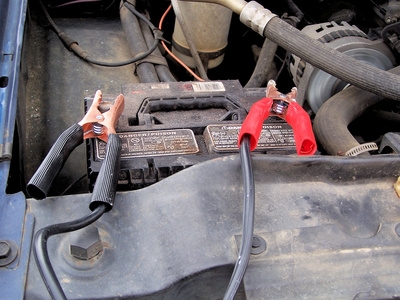
Almost everyone, at one point or another, has been stranded by a dead or nearly dead automotive battery. Whether you find yourself in a dark and dreary parking lot or in the driveway of your own home, booster cables (also known as jumper cables) are essential to get you on your way. You should always carry a good set of booster cables in the trunk of your car. However, simply having booster cables handy isn't enough. You also need to know how to use them properly.
Turn off all switches and accessories in the vehicle with the drained battery, and pop the hood.
Pull the vehicle with the fully charged battery close enough to the vehicle with the drained battery so the booster cables will reach. The vehicles must not touch, though. Turn off the booster vehicle, and pop its hood as well. If you are using only a fully charged battery as a booster, place it just close enough to connect it easily to the drained battery with the booster cables. Do not set the charged battery anywhere on the engine block, as it will just get in the way.
Use your post-and-terminal cleaning tool (or steel wool) to clean both batteries if they appear corroded or dirty. Clean terminals will ensure a better connection for boosting the battery.
Connect one positive clamp (usually red or yellow) of the booster cables to the positive terminal (marked with a plus sign) of the drained battery. Wriggle the clamp to make sure it is fastened securely to the terminal.
Connect the other positive clamp on the booster cables to the positive terminal of the fully charged battery. Again, check for a good connection.
Secure one negative clamp of the booster cables to the negative terminal (marked with a minus sign) on the fully charged battery of the booster vehicle.
Fasten the other negative clamp of the booster cables to a metal part on the vehicle with the drained battery. The metal piece must be unpainted and as far away from the battery as possible. Do not attach it to sheet metal or to any moving parts of the engine. An unpainted bolt or bracket will suffice. Attaching the clamp to the negative terminal could result in a short circuit and sparks that could ignite hydrogen gas emitted by a drained or damaged battery. The risk of this is small, but it's better to be safe than sorry.
Check all of the clamps to ensure that they are properly fastened to the correct terminals (positive to positive, negative to metal bolt or bracket), and start the booster vehicle. Allow the booster engine to run for a few minutes.
Start the vehicle with the previously drained battery. Allow both vehicles to run for about 3 minutes with the cables still in place. With the vehicles running, the drained battery will regain some lost power.
Disconnect the cables in the reverse order that you connected them. That is, remove the negative clamp from the metal piece first, then the negative cable from booster vehicle, and so on.
Do not shut off the vehicle that had the drained battery until you have driven it somewhere safe. Depending on the problem, you might need to boost the battery again or take the vehicle somewhere for diagnostics and repair.